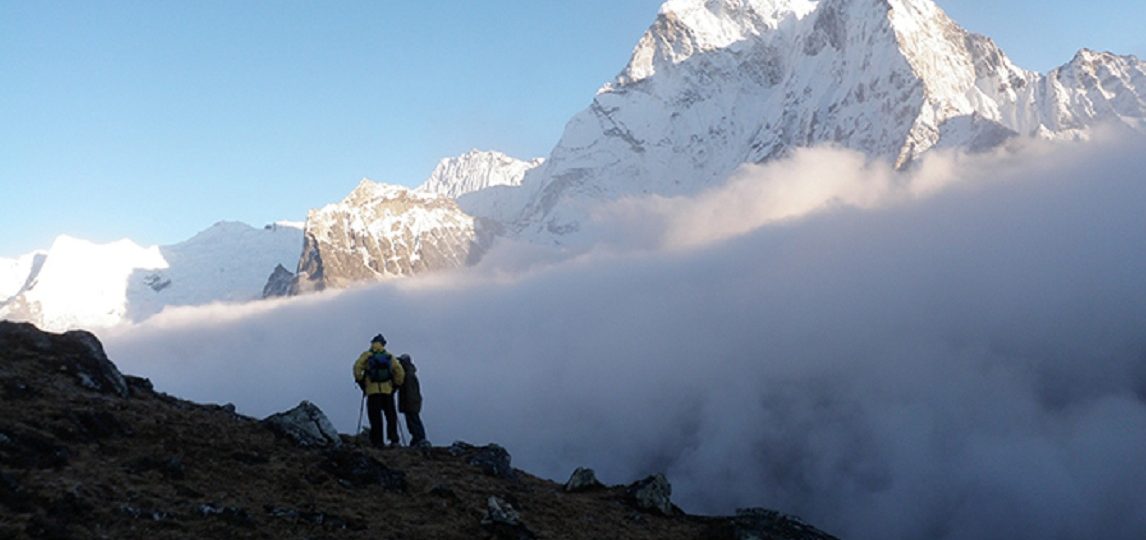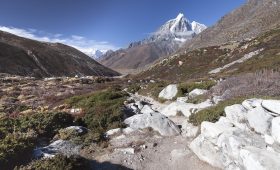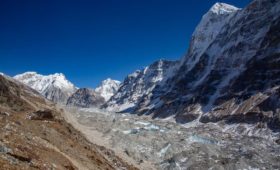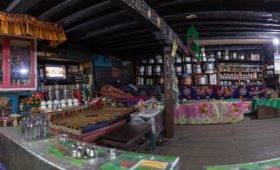The third highest peak in the world, Mt. Kanchenjunga (8,586 m), is located in Nepal’s far northeast corner and shared by India and Tibet. Kanchenjunga trek, one of Nepal’s most adventurous and challenging treks, involves difficult passes, valleys, wild rivers with glaciers, trees, and rocky trails
The Kanchenjunga trek is long and challenging, requiring a good fitness level with a backpack needed for three weeks of continuous walking.
These are for safety and helping people over short rocky parts. However, the trek doesn’t require climbing skills.
What are the Kanchenjunga Trekking routes from Nepal?
- North Base camp: Most challenging, steep trails. But it offers the best view of Kanchenjunga from top of Pong Pema, altitude ranges from 5000m to 5200m.
- Kanchenjunga South Base Camp: It has constant rising trails with highest altitude 4610m. up to Ramche.
- Sele Le Pass: Tricky due to snowfall most of the times.
What are the Kanchenjunga Trek Difficulty Factors?
- Isolation: Least explored trekking route. You can rarely see fellow trekker.
- High altitude 5200m.
- Challenging trails with passes, valleys, glaciers, dense forest.
- Vast diversity of topography, climate and vegetation.
- Physical fitness.
- Acute Mountain Sickness.
- The restricted trek permit is must.
What should you Consider before Planning the trekking?
When is the best time to trek to Kanchenjunga? Autumn and spring season are the best time to trek Kanchenjunga. From March to May and September to mid-December weather is permissible for trekking.
During winters temperature is usually -9°C to 12°C, even lower during nights and morning. There is snowfall in trials making it even more challenging.
During monsoon it is rainy, trails are slippery.
Passes and glaciers become unpredictable but if you are an adrenaline junkie and adversity, any time trekking can be for you with adequate preparation, guidance and caution.
Preparation even before you plan of Kanchenjunga trek:
You will be travelling from Taplejung (warm, flat altitude of 1400m) to Kanchenjunga Base Camp (5200m). You will need to be physically strong and mentally fit. Your health and stamina are foremost important. You will need per training and physical exercise.
Short hikes, swimming, yoga can open up your lungs. Amenities will be scarce as you ascend up and difficulties will come, thus you must be mentally prepared to give up some comfort for spectacular view of mountains and once in life time experience.
Can you go Kanchenjunga Trek solo?
Kanchenjunga trek solo is almost next to impossible. First and foremost, Nepalese Government requires 2 trekkers at least to provide the permit. Secondly you will be requiring guides and porters to lead you to the unexplored land of Himalayas and carry your luggage as you will need to pack essentials.
We at Himalaya Discovery can provide you with professional guidance from the time you plan your trek, prepare you with trainings, essential packaging list and trained guides.
How Safe is Kanchenjunga Trek?
It is difficult yet worth some trekking you will ever achieve. You will need to have travel insurance and safety plan. Rescue helicopter services are available in critical case as standby.
Best Time for Kanchenjunga Trek
The best time for hikes and other different activities around the Nepal Himalayas, including Kanchenjunga Trek. The ideal seasons are spring (March to May) and autumn (September to November).
Springtime brings longer, sunny days that allow you to trek further because there are more hours of sunlight. similarly autumn/fall of September to November is also the perfect time when most days are crystal clear for views and hikes.
However, because there are less hours of sunlight on shorter days, it gets dark early and the sunrise arrives late but is still enjoyable. In the morning and at night, it can get considerably colder, and there’s a potential of snowfall occasionally.
Kanchenjunga Trek difficulties – Few Tips
- Adequate time, planning and preparation. Detail knowledge about location, route and special permits, restricted areas. Physical fitness and climbing practice is required.
- Hire best company for professional guidance, itinerary to minimize the difficulty level. Our experience can assure you best service and mesmerizing trekking memories.
- Take leave of enough days to acclimatize the harsh climate and altitude. You will need to climb 500-700m each day, trek for 9-11 km that will be approx. 6-8 hours walk. You need to have altitude knowledge and importance of gaining constant height every day. “Climb high, sleep low”
- Acute Mountain Sickness (AMS) The most notorious difficulty in trek is Acute Mountain Sickness.
When we climb from lower height to higher altitude, oxygen content of air decreases, but our lungs are adapted to higher amount of oxygen. Thus, you may:
- Feel dizziness
- Difficulty in breathing
- Vomiting tendency
- Fainting as lungs start to fill with fluid instead of oxygen.
In such case
- You will need to climb downhill immediately.
- Never lay flat as it will increase fluid in lungs.
- Carry pulse oximeter to check oxygen concentration in blood.
- Drink plenty of fluids 2L/ day.
- You may not get mineral water.
- Carry water purifiers.
- Do not drink alcohol as it can cause dehydration
- Carry sweet snacks and stay nourished.
- Carry appropriate gears.
- First Aid kit must contain Diamox tablets (Acetazolamide) to treat AMS.
Getting Kanchenjunga Trek
There are two ways to get Kanchenjunga trek, by air one is pretty straight forward than by road. The flight to Bhadrapur would be my choice because it saves much discomfort and uncertainty, while also providing a bus opportunity to take in the local landscape.
Fly Kathmandu to Bhadrapur: (45 mins): The easiest way is to take the flight to Bhadrapur in 45 minutes. A small town in the south of the country on the plains. There are daily flights that will be arranged by your trekking company as the most of the price quotes includes transport. It’s a 10-hour jeep ride from Bhadrapur to Taplejung where the trek starts.
Fly Kathmandu to Suketar Flight: (1 hr. 15 mins): Fly into Suketer’s tiny mountain airport, this would be your best bet. From here it’s just a case of walking to Tapljung for about an hour. Unfortunately, weather conditions make it a very dodgy option. Flights are irregular and canceled on a pretty regular basis.
Kathmandu to Taplejung by Road: A road trip is always a possibility if you are up to the rigors of Kanchenjunga from day one. You will have to stop at either Bhadrapur or Birtamod before going on to Taplejung the next day.
If you’re thinking about a road trip, a private Jeep is by far the best option, hiring a vehicle in Kathmandu (your trekking company will arrange) gives you the choices and flexibility to stop off on the way, take things at your own pace and truly get ready for the journey ahead!
The other option is a local bus. There are several daily buses leaving Kathmandu from new bus park to Birimod (approx. 12 hours). Take a bus up into the hills to Taplejung the following day (10 hours). Any discomfort is more than just experiencing the various aspects of the country, culture and local people along the way.
Conclusion
Every mountain stands with its pride, diversities. Kanchenjunga stands with dramatic cliffs overlooked by mind blowing peaks. If weather is clear and you are lucky enough you can get spectacular view of Mt. Everest from Sele Le pass.
Being surrounded by cliffs only with green coniferous forest, rhododendron crimson bloom and snowy peaks, snow leopard or musk deer, yaks or black bear crossing your path, Kanchenjunga trek cannot be anything less than best off beaten trekking you will ever achieve despite all the difficulties.
We are here to make your memories yet the best ever! Please do not hesitate to contact us.
Do you have any question about trip to Nepal?
Tell us about your trip to Nepal and what you expect from it. We will answer your questions in 24 hours and help you design a trip with a comfortable itinerary to best meet your needs.





